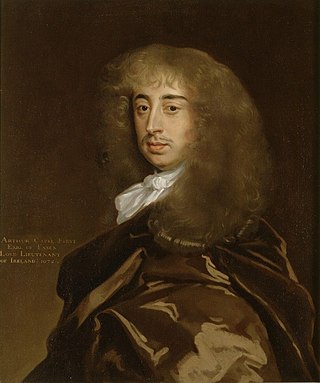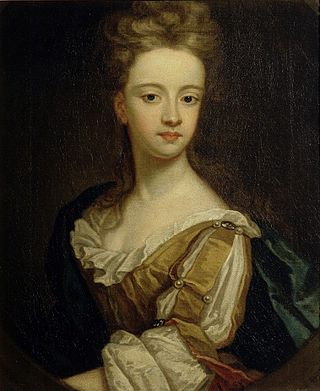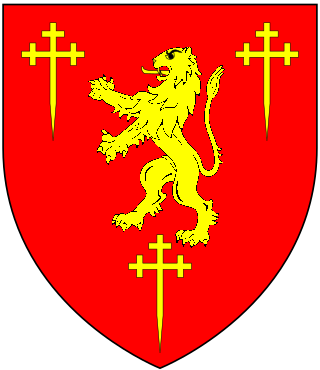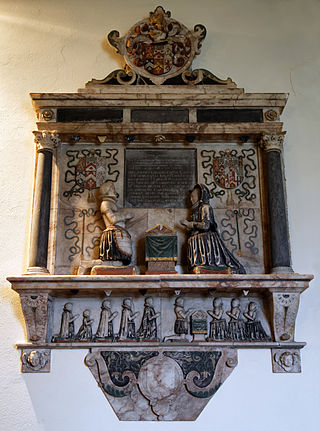
Arthur Capell, 1st Earl of Essex, PC, also spelt Capel, of Cassiobury House, Watford, Hertfordshire, was an English statesman.

Earl of Essex is a title in the Peerage of England which was first created in the 12th century by King Stephen of England. The title has been recreated eight times from its original inception, beginning with a new first Earl upon each new creation. Possibly the most well-known Earls of Essex were Thomas Cromwell, chief minister to King Henry VIII, and Robert Devereux, 2nd Earl of Essex (1565–1601), a favourite of Queen Elizabeth I who led the Earl of Essex Rebellion in 1601.

Henry Capell, Baron Capell of Tewkesbury KB, PC was an English politician who sat in the House of Commons between 1660 and 1692. He was then created Baron Capell.
Robert Montagu, 3rd Earl of Manchester JP was an English courtier and politician who sat in the House of Commons from 1660 to 1671 when he inherited the peerage as Earl of Manchester.

Abbess Roding is a village and former civil parish, now in the parish of Abbess, Beauchamp and Berners Roding and the Epping Forest District of Essex, England. The village is included in the eight hamlets and villages called The Rodings. It is in west Essex, 5 miles (8 km) north from Chipping Ongar, and 9 miles (14 km) west from the county town of Chelmsford. In 1931 the parish had a population of 169.

Arthur Capell, 1st Baron Capell, of Hadham Hall and Cassiobury House, Watford, both in Hertfordshire, was an English politician who sat in the House of Commons from 1640 until 1641 when he was raised to the peerage as Baron Capell. He supported the Royalist cause in the Civil War and was executed on the orders of parliament in 1649.

Little Hadham is a village and civil parish in the district of East Hertfordshire, Hertfordshire, England. At the census of 2001 it had a population of 1,081, increasing to 1,153 at the 2011 Census. It is bypassed by the A120 road, which connects it to the nearby town of Bishop's Stortford. The civil parish includes the hamlets of Bury Green, Church End, Cradle End, Green Street and Hadham Ford. Little Hadham, together with the neighbouring village of Much Hadham, are collectively known as The Hadhams.

Cassiobury House was a country house in Cassiobury Park, Watford, England. It was the ancestral seat of the Earls of Essex. Originally a Tudor building, dating from 1546 for Sir Richard Morrison, it was substantially remodelled in the 17th and 19th centuries and ultimately demolished in 1927. The surrounding Cassiobury Park was turned into the main public open space for Watford.
Capell or Capel is a surname. Notable people with the name include:
Lord John Grey was an English nobleman and courtier of the Tudor period, who after 1559 was seated at Pirgo Place in Essex.

Mary Capel, Countess of Essex, born Lady Mary Bentinck, was the daughter of William Bentinck, 1st Earl of Portland, a Dutch and English nobleman who became in an early stage the favourite of stadtholder William, Prince of Orange and his wife Anne Villiers.

Sir Capel Luckyn, 2nd Baronet of Messing Hall, Essex was an English politician who sat in the House of Commons at various times between 1647 and 1679.

Sir Charles Morrison, 1st Baronet of Cashiobury in Watford, Hertfordshire, was an English politician who sat in the House of Commons at various times between 1621 and 1628.
Sir Edward Montagu was an English landowner and politician who sat in the House of Commons in 1559.
Sir Henry Capell of Ubley, Somerset was an English politician.

Henry Capell, of Hadham Hall in the parish of Little Hadham in Hertfordshire and of Rayne in Essex, was an English politician.
Arthur Algernon Capell was an English aristocrat who succeed to the title Earl of Essex in 1839.
George Devereux de Vere Capell, 7th Earl of Essex, was a British aristocrat. He succeeded to the title Earl of Essex in 1892.

Sir Gamaliel Capell (1561–1613), of Rookwood Hall in the parish of Abbess Roding in Essex served as a Member of Parliament for the county seat of Essex from 1605 to 1613.
Elizabeth Harington was an English aristocrat.














